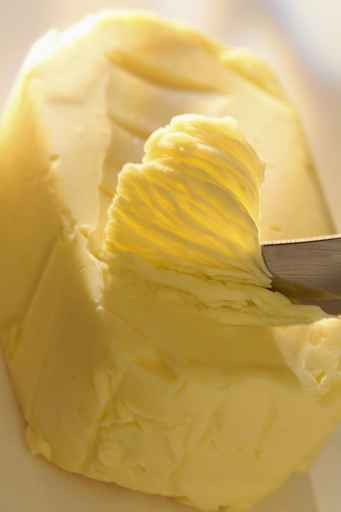Buttering Up

I just deposited my son at the airport, where he will wing his way from Paris to New York and his rigorous course of study. He is an art student, and six days a week he is in the studio honing his drawing and painting skills. When he isn’t doing that, he’s visiting the Metropolitan Museum of Art, dreaming of what he hopes to become.
Joe has learned that one cannot live on bread alone, and when I proposed to make him a bread and butter sandwich for the plane, he jumped at the chance.
I am a firm believer in carrying a snack along on a trip. Not just any snack. It’s got to be made of excellent ingredients, and it’s got to be simple. There cannot be a sticky or gooey element to it, or a drippy one either. That’s why I’ve been making butter and baguette sandwiches for trips as long as I can remember.
I buy the best baguette, this time one made by my friend Michel Amsalem, a local baker whose work of art is a baguette flavored with sesame seeds, which give it an extra toasty flavor. The butter? It was Au Bon Beurre, a Norman artisan butter that is the best in our neighborhood.
Billowy brioche
Butter here in France is an amazing thing. The French consume in excess of 17 pounds per capita a year. Even if you don’t know that, it takes just one visit to any supermarket to recognize the importance of butter in the French diet, as there are close to 20 varieties. Each has its unsalted (doux), fully salted (salé) or mildly salted (demi-sel) version. Some butters are churned rather than blended (beurre de baratte), some are blended with milk and cornstarch and labeled “lightened” (beurre allégé). Other butters are made on the farm (beurre fermier), with unpasteurized cream (beurre cru), or with organic cream (beurre biologique, or bio). No matter where butter is from, it holds pride of place in the cuisine.
This brings up the famous French paradox. Not the one about heart disease and foie gras, but the paradox about how the French eat so much butter and never seem to gain weight. Like any generalization, there are exceptions, of course. But people I know love their butter, and they all look just great. How do they do it? My conclusion, as a French person (I obtained French nationality over a year ago) is that we—the French—eat butter with near-impunity because we take so much pleasure in it. Being filled with pleasure while eating has a direct link to moderation. Thus, enjoying a heavily buttered tartine, a shattering-crisp croissant, a delicate slice of tart, a billowy piece of brioche, freshly steamed Brussels sprouts with butter, a small slice of toast spread with butter and topped with a gorgeous sardine or a perfectly butter-sautéed scallop creates satisfaction. There is no need for excess.
France is the major butter producer in the European Union, churning out nearly 450,000 tons each year. While Normandy is considered the country’s butter capital, there are those who take issue with that. Most of them are from Brittany, and they are correct. Norman butter is fantastic, but Breton butter is a work of art, particularly that made by Jean-Yves Bordier, who has a creamery in Rennes. His cows are Holsteins and Normans, the former a prodigious milk producer, the latter known for the unparalleled flavor and cream content of its milk. Monsieur Bordier comes from a long line of butter-makers, and has kept the old-fashioned ways in place. His butter is made slowly in small batches, and mixed with wooden rather than metal paddles. The result is the most tender, creamy butter imaginable. Bordier is considered the King of Butter, and he supplies most of the finest restaurants and shops in Paris and beyond.
One of Bordier’s colleagues, Olivier Martin, based in the Pas de Calais, is the maker of Au Bon Beurre butter. It’s soft and pale yellow, and packaged in parchment paper, or sold right from the motte, or chunk, at the farmers’ market. It is made with cream from Jerseys, Holsteins, and Norman cows and, according to Martin, it is the blend of the three varieties of cream that makes for the fine flavor of Au Bon Beurre.
In the winter, I either mail-order beurre Bordier, or I go to my local market and watch as the cheese vendor carefully slices off a hunk of Au Bon Beurre from a huge, ten-pound motte. Because I market early in the morning, I wait to have a tartine and coffee until after my shopping is done. Then I eagerly unwrap my Au Bon Beurre and inhale. The creamy-rich aroma and pale golden hue always makes me think of wealth. Butter signaled wealth to inhabitants of Rouen and Bourges, too—each of those cities has a tower on its cathedral called La Tour de Beurre, the Butter Tower. Built in the 15th and 16th centuries, these towers were paid for by parishioners buying dispensations from fasting during Lent, so they could go on enjoying their butter and milk.
Half a sandwich
But back to Joe’s plane fare. I sliced the baguette in half and spread one half with a generous amount of butter. We like salt in our family, so I sprinkled some fleur de sel on the butter before topping it with the other half. The baguette will rest in Joe’s bag for a while before his appetite wakes up and he remembers it’s there. If he’s still in the airport he’ll get a cup of coffee, unwrap it, tear it in half, and carefully stow one of the halves back in his bag. He’ll then dip the baguette into the coffee and savor it till it’s gone. Knowing him, he’ll want the other half right away too, but he’ll save it. Winter travel is sketchy, particularly this year as the heavens have dropped feet of snow in northern Europe, delaying plane, train and car. If he’s stuck somewhere along the way, he’ll at least have half a sandwich.
Back here on the ground in Normandy, whether the butter in question is one of the two greats like Bordier and Au Bon Beurre, or one of the more commercial but still very good butters found in the supermarket, it’s one more of all those good reasons for living in France.
THYME-STEAMED BRUSSELS SPROUTS WITH BUTTER
This is a quick and simple way to get the most from butter, by adding it to Brussels sprouts (or any vegetable) right after they have been steamed. The heat from the vegetables melts the butter gently, allowing it to keep its pure, creamy flavor. Serve these as a side dish with roasted chicken or grilled steak.
10 sprigs fresh thyme
1 lb (500 g) Brussels sprouts, trimmed, rinsed and thinly sliced
2 tbsp unsalted butter
Sea salt and freshly ground black pepper
1. Bring 3 cups water and the thyme sprigs to a boil in the bottom half of a steamer. Add the Brussels sprouts, cover and steam until tender, about 3 minutes.
2. While the vegetables are steaming, cut the butter into small pieces and put it in a bowl.
3. When the Brussels sprouts are tender, turn them into the bowl with the butter and toss them until they are coated. Season to taste with salt and pepper, and serve.
Serves 4.
Susan Herrmann Loomis teaches cooking classes in Normandy and Paris. www.onruetatin.com. The latest of her ten books, Nuts in the Kitchen, is published by HarperCollins. Find it in the France Today bookstore
Originally published in the February 2011 issue of France Today
For more food stories and French recipes
Share to: Facebook Twitter LinkedIn Email
Leave a reply
Your email address will not be published. Required fields are marked *



